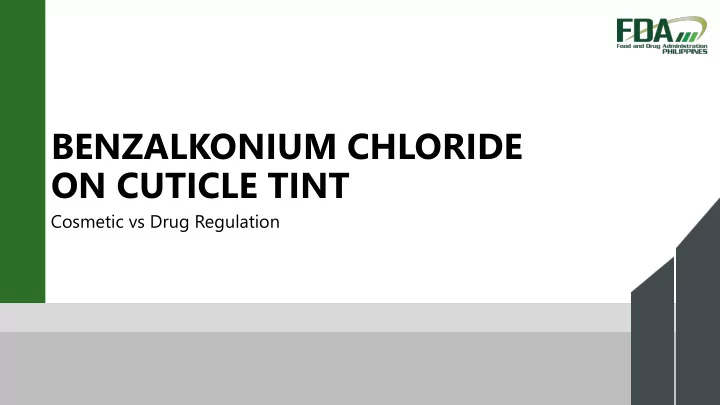

BENZALKONIUM CHLORIDE ON CUTICLE TINT Cosmetic vs Drug Regulation
Cuticle tints are used to: - Give color to nails - Clean, sanitize and disinfect nails after nail cleaning CUTICLE TINT
Drugs refer to: (1) articles recognized in official pharmacopeias and formularies, including official homeopathic pharmacopeias, or any documentary supplement to any of them, which are recognized and adopted by the FDA; (2) articles intended for use in the diagnosis, cure, mitigation, treatment, or prevention of disease in man or other animals (3) articles (other than food) intended to affect the structure of any function of the body of humans or animals; or (4) articles intended for use as a component of any articles specified in clauses (1), (2), or (3) but do not include devices or their components, parts or accessories DEFINITION OF DRUGS
Current Drug Regulation • Used as an active ingredient in products classified as household remedy (HR) • Used as an antimicrobial preservative in pharmaceutical formulations DRUG REGULATION
DR No. Generic Name Brand Strenth Form DRHR-1156 Benzalkonium Chloride --- 0.0125 Solution DRHR-1289 Benzalkonium Chloride --- 0.14% Tincture DRHR-222 Benzalkonium Chloride --- 0.0125 Solution DRHR-480 --- 0.013 Tincture Benzalkonium Chloride HRP-124 Benzalkonium Chloride --- 0.13g/ 100mL Tincture (0.13%) Benzalkonium Chloride --- 0.2% w/v Solution DRHR-1189 Benzalkonium Chloride --- 0.125g/100mL Topical Solution DRHR-1788 REGISTERED HR PRODUCTS
Cosmetic refers to: • any substance or preparation intended to be placed in contact with the various external parts of the human body (epidermis, hair system, nails, lips, and external genital organs) or with the teeth and mucous membranes of the oral cavity with a view exclusively or mainly to cleaning them, perfuming them, changing their appearance and/or correcting body odors and/or, protecting them or keeping them in good condition DEFINITION OF COSMETICS
ACD Ingredient Annexes • Used as a preservative up to a concentration of 0.1% (ACD Annex VI) • Allowed to be used other than as a preservative up to a concentration of: – 3.0% for rinse-off hair care products (ACD Annex III), and – 0.1% for other cosmetic products (ACD Annex III) – Antimicrobial , Antistatic, Deodorant, Surfactant COSMETIC REGULATION ASEAN Cosmetic Directive
ACD Appendix III – ASEAN Cosmetic Claim Guidelines • cosmetic products may also have a secondary , minor function that is outside the above scope (i.e. anti-dandruff, anti-bacterial, bust contouring, anti-acne) COSMETIC REGULATION ASEAN Cosmetic Directive
ACSB DECISION ON BORDERLINE PRODUCTS
Notified Cosmetic Products Brand Product Name % Function --- Cuticle Tint 0.20 Antiseptic --- Cuticle Tint with Benzalkonium Chloride 0.20 Antiseptic --- Cuticle Tint 0.20 Antiseptic --- Professional Cuticle Sanitizer 0.10 Antiseptic and Nail Tint --- Benzalkonium Chloride 0.10 Nail Tint --- Cuticle Sanitizer with Benzalkonium Chloride 0.10 Nail Tint --- Cuticle Tint 0.10 Disinfectant --- Moisturizing Cuticle Tint 0.05 Disinfectant --- Cuticle Tint 0.01 Preservative --- Cuticle Sanitizer 0.05 Preservative --- Cuticle Tint with Sanitizer 0.10 Sanitizer --- Cuticle Sanitizer 0.10 Sanitizing Agent --- ail Care – Cuticle Sanitizer 0.02 Antiseptic Benzalkonium chloride
Drug Cosmetic Regulation on Benzalkonium Chloride
COSMETICS DRUGS 1. Benzalkonium chloride as active 1. Benzalkonium chloride as preservative ingredient (antiseptic, antibacterial, in cosmetic preparations disinfectant) 2. Benzalkonium chloride as surfactant in 2. Benzalkonium chloride as preservative rinse-off hair care products in pharmaceutical preparations HARMONIZING THE COSMETIC AND DRUG REGULATION
Proposed Transition Period for Notified Products 1. Companies holding valid notifications shall be given two (2) years as transition period (until 31 December 2019) to apply for the appropriate LTO and CPR from CDRR 2. Labels of notified products not compliant with ACD regulations shall be allowed to be exhausted provided that the MAH shall provide FDA with the complete inventory of the following: • Manufactured/imported products with non-compliant label • Existing inventory of unused packaging materials. 3. MAH shall also be required to submit target exhaustion period and monthly status report on the exhaustion. TRANSITION PERIOD
THANK YOU.
Recommend
More recommend